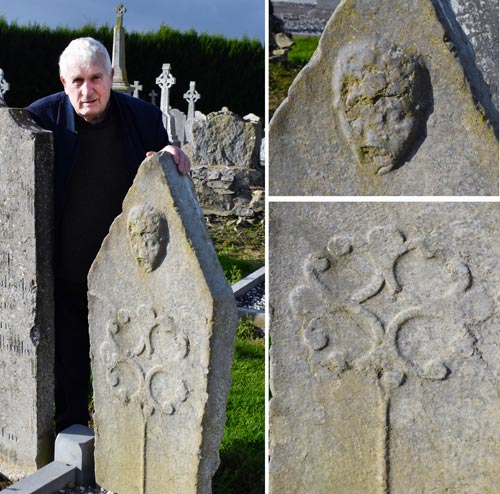Readers will remember we spoke, some weeks ago, of the remarkable restoration work being undertaken in the old section of Two-Mile-Borris Cemetery, by the T.M.B. Old Cemetery Committee. Their work last year led to the identification of the burial place of the parents of a former Bishop of Limerick, Right Reverend John Ryan D.D. (1828-1864), enabling a memorial plaque to be unveiled at the grave site, on Tuesday October 1st, 2024 last. [View HERE].
Visitors visiting this memorial plaque within the old cemetery may have their attention drawn to a most unusual upright and indeed rare, head-slab located a short distance away also within the old Two-Mile-Borris cemetery section, south of the burial ground’s main central crucifix. The head-slab can be immediately and easily identified because of its pointed top.

While the back of the west facing side of this limestone, flagstone (headstone) remains blank and undecorated; a most elegant, ornate Floriated Cross* cross and human head can be found; both hand-hewn in relief, on the front east facing side.
* A Floriated Cross is a cross with arms terminating in representations of flower petals. Same represent faith, wisdom and chivalry when used in heraldry, and the Trinity when used as a Christian symbol.
This tombstone follows in the classic head-slab style of such existing grave slabs, erected during the period between the thirteenth and fourteenth century.
The number of medieval slabs which feature a pointed top is very limited here in Ireland, with only 3 identified as having survived. A second example can be located at St. Canice’s Cathedral, Kilkenny City, Co. Kilkenny, while we learn that a third instance exists in the Cathedral at Newtown, Trim, Co. Meath.
In the United Kingdom, yet another example can be located on the site of St. Peter’s churchyard in Lewes, East Sussex, UK.
The pointed top of the Two-Mile-Borris slab is a unique feature amongst the body of Irish head-slabs, however, it does occur on other medieval sepulchral (stone room) monuments, though again not extensively.
While little information is known about the history of this head-slab’s initial raising in this thirteenth and fourteenth century period; local folklore related by Mr Bowe, suggests that this pointed top, thirteenth/fourteenth century slab, identifies the last resting place of an unknown Bishop, who it is said died, having fallen from a frightened horse, upon entering Two-Mile-Borris village, as he travelled westward towards Thurles Town, in Co. Tipperary.
One fact, however, which may contradict this folklore is that the face of this slab looks eastward. The practise of burying the dead so that their faces would reflect the rising sun, originally began with the Greeks and ancient Egyptians, latter who worshipped a sun god. Their dead would therefore face the sun each morning, permitting them to greet each new day.
The practice of east-facing tombstones within Christian communities is of course traced back to the Bible. New Testament scripture which records the second coming of Christ, states; “For as the lightning cometh out of the east, and shineth even unto the west; so shall also the coming of the Son of man be. (St Matthew’s Gospel, Chapter 24 : V. 27).
However, a notable and usual exception to this east facing rule, is that Church clergy, are buried facing west, (as indeed are often also senior army officers); based on the belief that, in the case of clergy at least, they too will rise, to face their congregation, and thus are positioned ready to lead same, yet again.
On the other hand, as Mr Bowe points out, local folklore may indeed be correct, as from antiquity Floriated Crosses has been identified as a symbol of purity by the Church. The design at the ends of the arms of Fleury Crosses often represent lily bloom; lilies representing the Blessed Virgin Mary and/or the Resurrection.

Leave a Reply